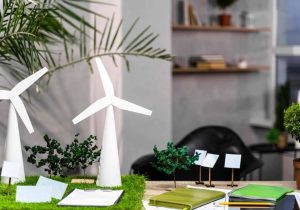Every year on June 5th, World Environment Day (WED) brings together millions of people from across the globe to raise awareness and take action on pressing environmental issues. This global celebration emphasizes the importance of sustainable living and the role individuals can play in protecting our planet. While World Environment Day often highlights broader environmental concerns, its principles can also be applied to our homes. By incorporating sustainable practices into home interiors, we can contribute to a healthier environment and create beautiful, eco-friendly homes.
In this blog, we will explore what World Environment Day teaches us about home interiors and how we can implement these lessons to make our homes more sustainable, stylish, and harmonious with nature.

One of the core lessons of World Environment Day is the importance of using sustainable materials. In home interiors, this means choosing eco-friendly building materials. Bamboo, reclaimed wood, and cork are excellent alternatives to traditional hardwoods. These materials are not only sustainable but also add a unique aesthetic to your home. For example, bamboo grows rapidly and can be harvested without causing significant damage to the ecosystem, making it an ideal choice for flooring and furniture.
Traditional paints and finishes often contain volatile organic compounds (VOCs) that can harm both the environment and indoor air quality. Opt for low-VOC or zero-VOC paints to reduce indoor pollution and create a healthier living environment. These paints are available in a wide range of colors and finishes, allowing you to maintain your home’s style while being environmentally conscious.
Incorporating recycled and upcycled materials into your home decor is another effective way to embrace sustainability. Look for furniture made from reclaimed wood or recycled metal, and consider DIY projects that give new life to old items. Upcycling not only reduces waste but also adds a personal touch to your home decor.

World Environment Day emphasizes the importance of reducing our carbon footprint. One way to achieve this in your home is by using energy-efficient appliances. Look for appliances with the ENERGY STAR label, which indicates that they meet strict energy efficiency guidelines. These appliances use less energy, saving you money on utility bills and reducing your environmental impact.
Incorporating renewable energy sources into your home is a significant step towards sustainability. Solar panels are becoming more affordable and can be installed on rooftops to generate clean, renewable energy. Not only do solar panels reduce reliance on fossil fuels, but they can also lower your electricity bills over time.
Smart home technology can also contribute to energy efficiency. Smart thermostats, for example, learn your heating and cooling preferences and adjust the temperature automatically, reducing energy consumption. Smart lighting systems can be programmed to turn off when not in use, further cutting down on energy waste.

Water conservation is a critical aspect of environmental sustainability. Installing low-flow fixtures in your home can significantly reduce water usage. Low-flow showerheads, faucets, and toilets are designed to use less water without compromising performance, helping to conserve this precious resource.
Rainwater harvesting systems collect and store rainwater for various uses, such as irrigation and toilet flushing. This practice reduces the demand on municipal water supplies and lowers your water bills. Simple rain barrels can be installed under downspouts to collect rainwater, while more advanced systems can be integrated into your home’s plumbing.
Greywater recycling systems treat and reuse water from sinks, showers, and laundry for non-potable uses like irrigation. By reusing greywater, you can reduce the amount of fresh water needed for these purposes, contributing to overall water conservation efforts.

Houseplants are not only aesthetically pleasing but also help improve indoor air quality. Plants like spider plants, snake plants, and peace lilies can remove toxins from the air and increase oxygen levels. Adding greenery to your home can create a healthier, more inviting environment.
Proper ventilation is crucial for maintaining good indoor air quality. Ensure that your home has adequate ventilation systems, such as exhaust fans in kitchens and bathrooms, to remove pollutants and moisture. Opening windows regularly can also help circulate fresh air and reduce indoor pollutants.
Switching to natural cleaning products can reduce the number of harmful chemicals in your home. Many conventional cleaning products contain ingredients that can negatively impact air quality. Opt for eco-friendly cleaners made from natural ingredients like vinegar, baking soda, and essential oils.

Composting organic waste is an effective way to reduce the amount of waste sent to landfills. Kitchen scraps, yard waste, and even some types of paper can be composted to create nutrient-rich soil for your garden. Composting not only reduces waste but also helps enrich the soil and promote healthy plant growth.
Participating in local recycling programs is essential for reducing waste and conserving resources. Ensure that you are familiar with your community’s recycling guidelines and properly sort recyclable materials. Many communities also offer recycling programs for electronic waste and hazardous materials.
Adopting a minimalist lifestyle can also help reduce waste. By focusing on quality over quantity and purchasing items that are durable and long-lasting, you can reduce the need for frequent replacements. This approach not only minimizes waste but also promotes a more intentional and clutter-free home.
World Environment Day serves as a powerful reminder of the importance of sustainable living. By incorporating the principles of sustainability into our home interiors, we can contribute to a healthier environment while creating beautiful, functional homes.
At Bonito Designs, we understand the significance of sustainable design. Our full-home interior design services not only focus on aesthetics but also prioritize environmental responsibility. With over 300 skilled designers, we offer end-to-end services, ensuring your home is both stylish and eco-friendly.
Quality is our top priority. Each project undergoes seven quality checks and over 400 tests to ensure the highest standards are met. We pride ourselves on timely delivery, completing home projects in just 90 days. With in-house manufacturing, every element is built from scratch, guaranteeing precision and excellence.
As the first-ever ISO certified brand in interior design, Bonito Designs is committed to providing top-notch services. We offer easy EMI options, making it simpler for you to achieve your dream home without financial stress. Whether you’re inspired by eco-friendly materials, energy-efficient solutions, or innovative water conservation methods, Bonito Designs is here to help.
Contact Bonito Designs today to start your journey towards a sustainable and beautifully designed home. Our branded home interior services ensure that your home is not just decorated, but thoughtfully designed to reflect your unique style and needs. Let us help you create a home that’s as practical as it is stunning, all while being kind to our planet. Together, we can make a difference, one home at a time.